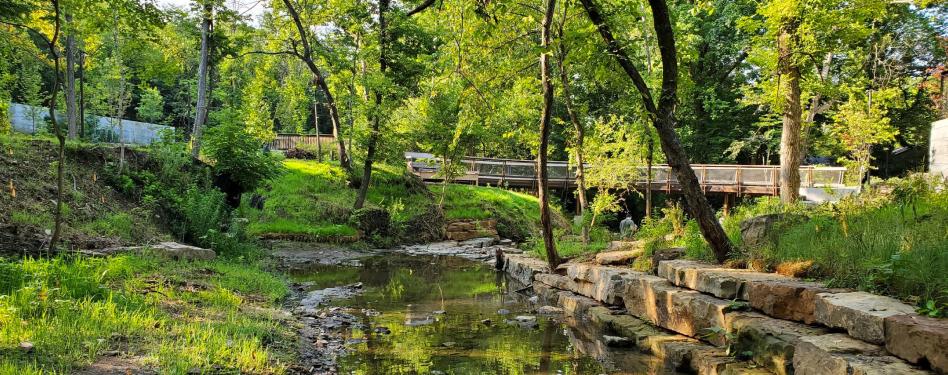
Feature image: The SITES Silver Cultural Arts Corridor Lower Ramble in Fayetteville, Arkansas. Photo courtesy of the City of Fayetteville.
More than 315 registered and certified SITES projects—spanning 20 countries, 31 U.S. states and the District of Columbia—are focusing on enhancing biodiversity. Covering 1.26 billion square feet, these projects range from university campuses, hotels and resorts, government facilities, and public parks to commercial headquarters and mixed-use developments.
Administered by GBCI and complementary to LEED, SITES certification promotes sustainable and resilient land development and can be used on sites with or without buildings to foster biodiversity, address climate change and improve resilience. The need for sustainable land development has never been more important.
The vital importance of biodiversity
Biodiversity, a term that is truncated from “biological diversity,” refers to the variety of life on Earth, from bacteria to entire ecosystems. We depend on biodiversity for food, medicine, energy, clean air and water, and even economic success. Ecosystem services delivered by biodiversity are valued at more than 1.5 times the annual global GDP.
Biodiversity, resilience and climate change are also inextricably connected. Land and the ocean absorb more than half of all carbon emissions and could provide roughly one-third of the mitigation efforts needed in the next decade through conservation and restoration.
However, today more than one million species and their ecosystems are threatened with extinction. In 2019, the Intergovernmental Science-Policy Platform on Biodiversity and Ecosystem Services (IPBES) Global Assessment Report on Biodiversity and Ecosystem Services, the most comprehensive ever completed, kick-started global concern about our impact on the planet.
“The health of ecosystems on which we and all other species depend is deteriorating more rapidly than ever. We are eroding the very foundations of our economies, livelihoods, food security, health and quality of life worldwide,” said IPBES chair Sir Robert Watson in the announcement. “The report also tells us that it is not too late to make a difference, but only if we start now at every level, from local to global.”
The landmark Kunming-Montreal Global Biodiversity Framework, passed in December 2022, laid the groundwork for a path forward. Enacting this vision will require global transformation that addresses the five main threats to biodiversity:
- Land and water use
- Invasives species
- Pollution
- Overexploitation of resources
- Climate change
Nature-based solutions found in SITES
Any project with a landscape can support this critical work. Nature-based solutions in the SITES v2 rating system are key to supporting a healthy, biodiverse future. As a comprehensive guide to landscape development, SITES is uniquely positioned to address all five primary threats and to guide property owners, developers, designers and others in prioritizing biodiversity within their projects.
The SITES integrative design process brings all necessary voices to the table throughout the design and development process, allowing biodiversity to be a key project consideration from the onset. Key strategies include
- Requiring the conservation of existing critical, rare, sensitive and healthy areas like floodplains, wetlands, and threatened and endangered species habitats.
- Providing guidance to understand connections to local habitats.
- Prohibiting the use of invasive plants and requiring a multiyear invasive-species control and management plan.
- Emphasizing the importance of healthy soil throughout the process, including protection and restoration tactics, so it can provide a foundation for vegetation and habitat.
- Prioritizing restoration using native plants and creating habitat where land has been degraded.
- Including guidance on sustainable material sourcing alongside strategies to reduce pollution and resource consumption.
- Sharing guidance and education for contractors on protecting and managing healthy soil and vegetation.
SITES projects are making a difference
Through SITES, projects maximize their value by enhancing local biodiversity, mitigating climate change, bolstering resilience and protecting critical ecosystems. Jump into case studies from existing SITES-certified projects to learn more about the differences this certification can make:
- Xuhui Runway Park in Shanghai, China
- Columbus U.S. Land Port of Entry Expansion in Columbus, New Mexico
- Expedia Group Headquarters in Seattle, Washington
- West Laurel Hill’s Nature Sanctuary in Bala Cynwyd, Pennsylvania
